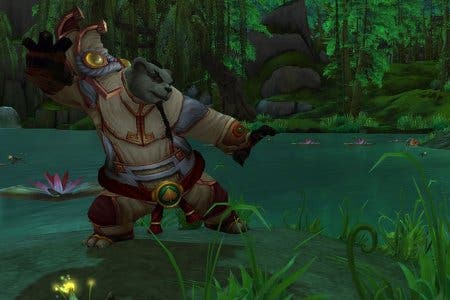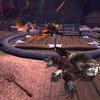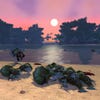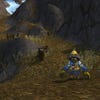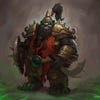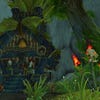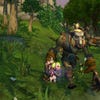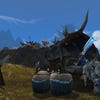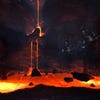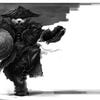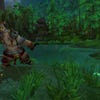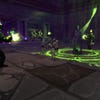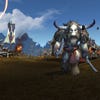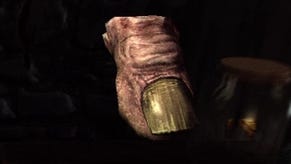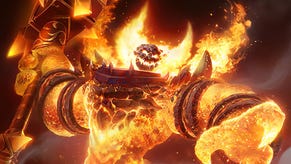WOW: Mists of Pandaria Preview: Blizzard's Eastern Promises
The art of war.
To Blizzard's credit, it hasn't shied away from addressing the quizzical looks that many players assumed following the announcement at BlizzCon 2011 that the Pandaren - a panda-like race that debuted in an April Fool's joke - would be the focus of World of Warcraft's fourth expansion. That a peaceful, innocent race quietly munching away on bamboo in the isolated mists of the Isle of Pandaria should be a necessary component in the promised grand vision of a return to war between the Alliance and Horde faction is a theme that jarred for many.
At last week's preview event for the upcoming fourth expansion, we got more than a little extra of the message that somehow struggled to make it from those attending BlizzCon to those receiving the information at home.
It starts with the world itself, and the art of Pandaria is predictably drawn from Eastern architectural influences - pagodas and paddy fields, decorated with deep reds and delicate ornaments. While the rugged and Nordic Northrend was a high point for Blizzard's artistic vision, it's arguably been trumped by the efforts in this new expansion - a Great Wall of Pandaria strides across a zone, factional hubs are occupied by cutlass-wielding stone giants, and hanging bells and blossom trees adorn the pagodas and outcrops of the land. Bejewelled and beguiling, it's a pristine and intricate look, with a far greater focus on the finer details than the broad texture swathes that have typically dominated WOW's art style in the past.
The Eastern styling is notably apparent in the first Pandaren dungeon, the Stormstout Brewery. While this is a fresh and fun change of pace from the game's more typically po-faced content, it's also unlikely to settle the nerves of any players who responded with shock to Pandaria's unveiling or soothe the concern that WOW might finally be jumping the shark.
In this setting, the ferociously alcoholic Hozen - the land's malevolent monkeys - have overtaken the brewery and are having no trouble organising a piss-up. After running through an endless gauntlet populated by the rat-like Vermin, armed with explosive bomb barrels (or hammers that can be stolen and turned against them), players assault the boss Hoptalus, a giant take on these creatures, and one who wields a vicious 'Furl-wind' attack.
Shortly afterwards, players face off against the 'Ale-mentals', the brewery's version of the elemental whirlwinds that have populated WOW's green and pleasant lands since launch. The final boss takes the form of Yan Zhu The Uncasked, blessed with the ability to make beer pour from a player's ears, damaging any other party members who happen to be standing by. Have no doubt that this is WOW at its most light-hearted, but it does work - and there is a reassuring gravity to be found elsewhere.
As with the heroic versions of the original Deadmines and Shadowfang Keep dungeons - re-imagined for 2010's Cataclysm expansion - player-favourite Scholomance is next for a makeover, and it plays the haunted house perfectly as the eyes of portraits hanging from the walls follow you around the rooms. At the conclusion of the dungeon, Darkmaster Gandling himself revels in a more aesthetically accomplished form, streams of fire working both around him and high into the newly raised roof.
While the previous dungeon redesigns were well-received they were, for many, inaccessibly difficult - particularly for those taking part in random groups, where a little knowledge doesn't just go a long way, it's sometimes necessary in order to get you through the front door. "We definitely want the level 90 dungeons to be challenging to the players," explains Ray Cobo, senior game producer for World of Warcraft, when I ask him about the difficulty of balancing the game for those seeking the hardest of challenges, and for the more casual or inexperienced players.
"But we don't want it to be 'hit your head against the wall' challenging. So I think there's a fine line there, and that's something we're constantly trying to make sure we're on the right side of. So yes, we want to keep them challenging, and for the hardcore players that really want a challenge, Challenge mode is perfect."
As much as the game benefited from the dungeon finder system, WOW has also suffered from the community isolation that it brought with it - teaming up with strangers from foreign realms, free of social repercussions, led to an often abrasive and ill-mannered experience. At best it resulted in many players barely leaving the major cities as they queued for endless, teleported dungeon runs. It's a long way from the social experience that united players of all levels in 2005's Gates of Ahn'Qiraj event, where each faction drew together to gather materials for the war effort.
The solution presented in Pandaria is the Challenge mode, which will complement the nine Level 90 dungeons and three raids provided at launch. Beloved and cursed in equal measures, memories of the so-called 'Baron Run' of WOW's early years - which tasked players with saving a prisoner within a strict time limit - has been the inspiration for this new system. There'll be three tiers of timed success - Bronze, Silver and Gold - with each providing rewards appropriate to their difficulty.
Not only will clearing all of the expansion's dungeons at a Gold standard award players with a unique mount and armour set, successful runs will also be added to an in-game leaderboard, detailing who ran what with whom, and providing bragging rights and a local challenge on each server. While the armour sets will be stat-free, they can be functionally upgraded using the recently-introduced Transmogrification system, and will also feature animations unique to each class: activate a certain ability, and the magnificent dragon heads adorning your shoulders will seethe with billowing smoke, for example.
Acutely aware of the ferocity with which players consumed Cataclysm's content, there's an obvious sentiment on Blizzard's part that it needs to work harder with players left uninterested or intimidated by the challenges of WOW's traditional end-game - heroic dungeons, raiding or player-versus-player.
The Valley of the Four Winds houses the verdant farmlands of the new continent, a land of multi-coloured paddy fields tiered across the valley. Each player will have their own personalised farm - instanced in the open world, presumably utilising the phasing technology introduced in Wrath of the Lich King - where they can tend to individual plots that complement their chosen professions. Seeds can be planted one day and harvested the next to gain herbs for example, or master chefs can opt to grow their own ingredients. As you make progress with the farming Tiller faction, your options to upgrade your land will broaden.
The faction reputation system has previously been represented by a progress bar, a cold and numerical way of measuring a visually static relationship with world inhabitants. Where Blizzard is seeking to revolutionise the system this time around is in lending a more aesthetic, world-based visualisation to progress and acceptance with all of the factions in the expansion. It'll also take time to foster these relationships. "Because we know that the players are going to go through the level-up content very quickly, we have so much more end-game content," Cobo explains. "It's more than we've ever done in an expansion - tons of dailies, it takes weeks and weeks for each faction to do."
Unlike in Cataclysm, players will be restricted from using their flying mounts until they reach the new level cap. At this point, a series of daily quest goals will be made available, offering the chance to work with the flying trainers in order to raise your own mount from an egg to a hatchling to a fully-grown Chinese Dragon mount, complete with smoke twirling from its nostrils.
But if players have started to tire of these standard end-game content systems in a game approaching its eighth year, there's a more troublesome storm brewing on the horizon as players seek the steady stream of dynamic experiences promised by the likes of Guild Wars 2. Blizzard's answer to this is the Scenario system that offers instanced, instantaneous bite-sized slices of group content, free from the requirements of a tank or healer. Most of these will be uncovered through conversations with the roaming brewmasters that wander the land, and there'll be approximately eight to ten of them at launch.
In future patches, the briefer nature of these Scenarios will allow the developer to delve into areas of the game previously untapped, whether due to the time involved in processing entire dungeons, or creating storylines worthy of Blizzard's standards.
"It definitely adds more value to certain segments of the world that we may not have taken advantage of before, " Cobo explains. "We might have underused certain areas of the game, but then we can go back and say, 'Hey, what about this area? This would be a great place to pop in this thing - put an outdoor boss or something here.'"
While each Scenario will be a strictly three-man affair at launch, Blizzard plans to increase the group size in the future, even teasing the possibility of 40-man onslaughts. For today though, Lightning Logger was the Scenario on show, requiring players to save the brewery of a Pandaren damsel in distress by tackling waves of enemies, literally fighting fires and then facing - what else - an enormous boss.
This recognition of the need to keep players' attention engaged with more frequent content updates is the driving force behind the development process of the expansion. We're promised that the boxed release of Pandaria will tell a distinct story by itself, while more frequent patches will - it's revealed - lead to an assault on Orgrimmar itself in order to end Warchief Garrosh Hellscream's tyrannical reign. Mists of Pandaria may tell the story of a fragile and vulnerable nation, but it's the content patches that will deliver the war back into Warcraft.
Those who have previously shied away from end-game group content - and who may still prefer to do so - have in the past been restricted to achievement hunting or collecting the multitude of pets and mounts that litter the game. Until now a purely cosmetic endeavour, the new pet battle system will add a sense of purpose to hunting down the critters of Warcraft.
Set on the day to the placeholder battle music of Final Fantasy 7, Illidan and Arthas faced off with a series of pet fights, each companion possessing a clutch of simple abilities designed to counter each other during turn-based rounds. Blizzard was keen to stress the non-competitive nature of these battles, with an aim to satisfy those intimidated by the competitiveness of traditional player-versus-player combat. For this new feature, players will be matched anonymously and with no permanent record of wins and losses, or details of who bested who.
More traditional competitors will be serviced with a fresh round of another staple of the modern MMO, the instanced PVP battleground - one of which will be heading underground for the first time. There'll be two new zones in total, with the first introducing a familiar, artefact-based gameplay to WOW. Those holding the artefact accrue points for their team, and the closer to the dangerous centre of action the player is, the higher the points that are awarded. The holder will also gain a powerful damage buff, albeit at the expense of reduced healing in what is currently envisaged to be a 10 vs. 10 player battle set in a grand pagoda.
More interesting is the mining battleground that's notionally situated under Stranglethorn Vale, and sees the Alliance and Horde compete to control the mine-carts that trundle towards various nodes, rewarding the successful team with a delivery of points. The catch in this particular instance comes from the levers that can be fought over, diverting each cart towards a lengthier route home. Again, the art team triumphs first and foremost with sparkling diamond nodes that litter the ground, while trickling rivulets of water run along the floor and gushing waterfalls adorn the distant walls.
Later in the day we had the opportunity to take a hands-on turn with a high-level Pandaren at a crash site hidden in the Jade Forest zone. Playing as the damage-dealing Windwalker flavour of the new Monk class, there was a satisfyingly complex synergy required in juggling a combat resource system that resembles a combination of a rogue's energy bar with a Death Knight's rune system.
It's also a class that's tremendously fluid in movement, and possessed of some uniquely advantageous movement abilities on the battlefield. How these advantages will balance with the comparatively less mobile, rock-paper-scissors combat of existing classes in PVP will be a charged debate - and one that will likely be the decisive factor in a sceptical audience's acceptance of this class.
The more inventive streak for quest design that Wrath of the Lich King introduced continues to entertain and evolve from the typical gather-five mentality. At a crash site in the forest, the first order of the day is to pay respect to the fallen Horde that litter the landscape. Unfortunately, there's nothing on hand except a catapult and the wild blue yonder, but any port in a storm as the dead are ungracefully dispatched into the sky before plunging into the sea.
Essential supply crates that lie on a low ledge of the cliff edges can only be accessed by bungee- jumping off an exposed root and snatching them up one at a time. Later on in the quest line, your character travels to Ogrimmar where the tyrannical Garrosh watches as the scene of the carnage and crash is played out on a map that lies on the rug in front of him.
Something needed to change before the ennui of over a million players cancelling their subscriptions spread further. WOW is as much a cultural phenomenon as it is a game, and that sense of belonging to a thriving world and a shared experience has underpinned much of its success. Regardless of its origin, the introduction of an element of levity to a core part of the game need not be the end of the world many doomsayers would like to believe.
It may have been lost in the diluted message of the expansion's announcement, but there's no shortage of fan-service in Mists of Pandaria. There's also a creeping suspicion that it's the players' corruption of a gentle, innocent race that will ultimately add meaningful context to the promised return of war.
